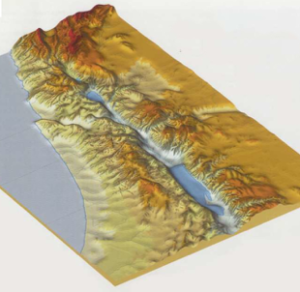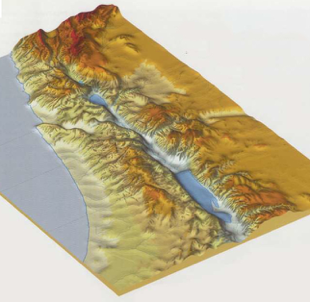N.B.: I am in the Holy Land at this time. As my travel schedule is heavy, I am republishing some articles about life in Jesus’ day. I hope you will enjoy reading (or re-reading) them as much as I did.

Nomenclature – The land today called Israel or the Holy Land, was known to the Greeks and Romans in Jesus’ day as Palestine. This name came from the Philistines, who had lived there some 2000 years before Christ.
The Jewish people, however, never called their land Palestine, although they did use that name to refer to an area near the Mediterranean. They tended to refer to their land is the “Promised Land,” or the “Land of Canaan.” They also spoke of it as the “Land of Judah.” The Talmud simply calls it “The Land.”
Geologically, the Holy Land is a volatile area. Earthquakes and volcanoes have plagued the region for millennia. Numerous plates and rifts run under and adjacent to it. Although many think of the Bible lands as flat, desert landscapes, the region is in fact better described as mountainous (or at least hilly) and has areas that are quite green.
Much of the diversity in terms of vegetation can be seen in the rather significant hills, which stretch from Judah in the south all the way up through Galilee in the north. Although areas to the east are dry, these hills tend to collect the Mediterranean moisture and concentrate it in that region. They are not steep, high mountains like the Rockies, but neither are they small hills. In many areas they resemble the Appalachians here in the United States in terms of slope and height.
Although forests are not widespread in the Holy Land, there are numerous trees in the Mediterranean hills. Sadly, many areas that were once more heavily forested have been deforested. The slender band of forests along the western side of Israel just east of the Mediterranean Sea is sometimes called the Mediterranean Forest. It is not a dense forest, but it is dotted with small pines and oaks. Between the foothills and the encroaching deserts to the east are the steppes—areas filled with low shrubs and wild grasses. These regions are devoid of trees but are particularly good for shepherding. Due to the copious rainfall, the western side of modern Israel was the favored land. This was Canaan, the land of milk and honey.
The Sea of Galilee is actually a freshwater lake. It is 700 feet below the level of the Mediterranean Sea and surrounded by gently sloping hills that descend from the mountains in the west to the lake that is today called Kinneret. Galilee is a beautiful region with reasonably abundant rainfall and it supports various types of agriculture as well as the tending of flocks.
Geographically, the land is rich in complexity, featuring a coastal plain, a semi-mountainous hill country in Judah and Galilee, the wide valley of Jezreel, and a fertile sloping region in Galilee that sloped down to the Sea of Galilee. A tremendous rift in the earth makes up the southern part of the Jordan River near Jericho and the Dead Sea. There is the deep desert of Judah, which swings around south and west to the Negev. West of the Jordan is the steppe and the dry, barren Golan Heights. There is the snow-covered Mount Herman to the northwest and the rich stands of cypress trees in Lebanon to the northeast.

It is a land of great variety and the terrain is incredibly complex. This brings about dramatic, localized effects on the weather and vegetation. Fertile valleys can give way to deep desert within miles. Just to the west of Jerusalem are the green hills of the Judean Hill country that (as previously noted) resemble the Appalachians. Yet just to the east of Jerusalem, over the Mount of Olives, begins a 3500-foot descent into the deep and extremely dry desert of the Dead Sea and Jericho (see photo at right). At 1400 feet below sea level, the Dead Sea is the lowest place on earth. There, two plates in the earth’s crust are opening up.
Indeed, there is probably no place on earth like the Holy Land in terms of the incredible diversity in such a small area. A walk of one hour can take one from one of the richest valleys, up over barren hills, and down on the other side into the hot wind of the desert. And on a clear day one can see the snow shining on Mt. Herman in the north.
It is likely that at the time of Jesus the Holy Land had more greenery than it does today, but not so much more that it would be unrecognizable to an ancient Jew. The diversity described here still existed at that time.
The people who lived in Jesus’ time were surely a hearty stock to be able to thrive in such a wide rage of conditions.
Here’s a video I created that might help to give you a better feel:

